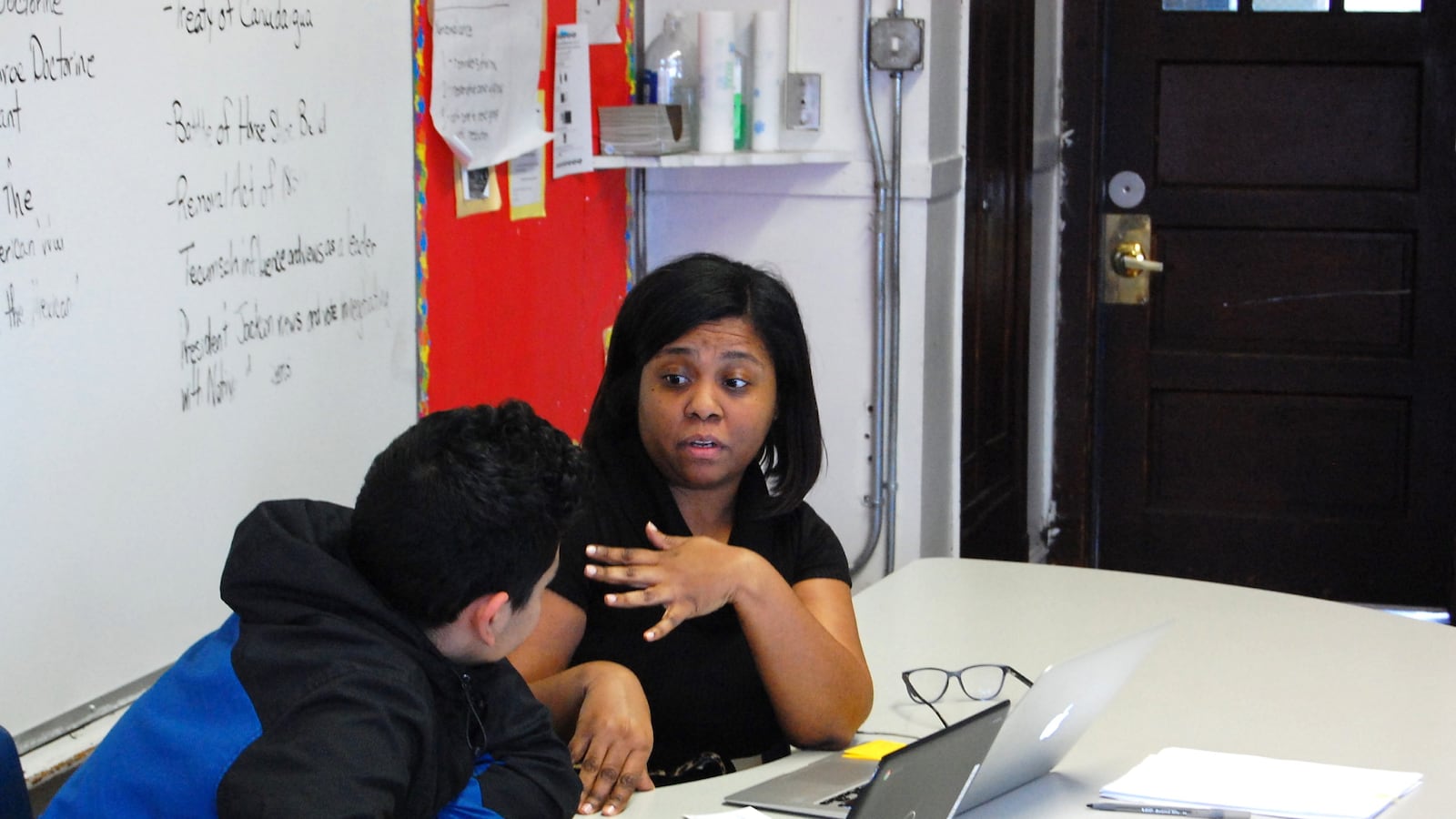CHICAGO — Teacher Traci McCullough sat beside an eighth-grade student, her laptop open, scanning the notes he had left her ahead of their mentoring session. Lots of complaints about science, she noted.
“Without teacher-bashing, what is the deal?” asked McCullough, who teaches English and history.
As the student started to explain, McCullough clicked through a computer program. He hadn’t submitted a science project on time, she saw, hurting his grade. She nudged the student to email his science teacher.
“We’re going to word this correctly — you get more flies with honey than you do vinegar,” she said. “I would start off with what you have done, and then build off of that and what you need help with.”
“Science is not my specialty,” the student said, as his classmates worked independently on math problems behind him.
“But this looks good,” McCullough said, pointing to a chart he’d made for another assignment. “Give yourself some credit.”
The interaction took place earlier this week at Chicago International Charter School Bucktown, an early adopter of Summit Learning, the Mark Zuckerberg-backed “personalized learning” program that launched five years ago and is now used in some 400 schools across the country.
That kind of one-on-one communication between teachers and students is increasingly at the heart of Summit Learning’s public pitch, as it tries to make its way into more schools amid skepticism about students’ screen time and pushback in schools where some say the program relies too heavily on computers.
“This is this concrete thing that the schools that are part of the Summit program actually do,” said Sarah Reckhow, an associate professor at Michigan State University who studies the role of philanthropy in schools. “And mentoring is very popular. Who doesn’t want their kid getting one-on-one attention?”
Students who attend schools that use Summit Learning split their time by working on group projects, completing self-directed work on computers where they move at their own pace, and receiving traditional classroom instruction. When students are working independently, teachers can meet one-on-one with students.
The platform, which is free for schools to use, was developed with the help of Facebook engineers and has received tens of millions of dollars in funding from the Chan Zuckerberg Initiative, the philanthropic organization backed by Zuckerberg and his wife, Priscilla Chan. (CZI also supports Chalkbeat.)
Summit Learning formalized the mentoring component in the summer of 2018 when it added a tool allowing teachers to automatically schedule time with students and offering agendas to structure that time, said Kate Bondurant, a spokesperson for TLP Education, the nonprofit that runs Summit Learning. TLP recently took over the program from Summit Public Schools, the charter network where the model was first created.
More recently, the organization has placed a heavier emphasis on marketing the mentoring aspect of its program. Newspapers across the country have run opinion pieces about mentoring and Summit Learning over the last month and a half, bylined by local educators. Some contain identical or nearly identical language.
“Reaching students is bigger than just one teacher and one student; it builds a culture of learning with students at the wheel,” wrote two Nevada teachers from a school that uses the program.
“Mentoring is bigger than just one teacher and one student. It builds a culture of learning with students in the driver’s seat,” wrote a Washington teacher at another Summit Learning school. An Idaho teacher from a third school using the program wrote the same thing.
A spokesperson for TLP Education did not respond to a question about the similarities.
“While mentoring is an important part of the Summit Learning program throughout the school year, National Mentoring Month was a special time for teachers and students to highlight the importance of mentoring and celebrate the successes they are experiencing as a result,” Bondurant said, noting the organization marked this event last January, too. (The month was established in 2002 under President Bush.)
Summit Learning’s focus on mentoring is part of a larger trend among advocates of personalized learning to de-emphasize technology in their communications. It’s also not necessarily unique — schools across the country have created intensive advisory periods or mentoring roles.
But teachers like McCullough say the specific tool helps. McCullough, who was recognized by her school for her mentoring work and later was highlighted in a CZI press release, has 15 or so mentees who she meets with for around 10 minutes every week or every two weeks, though it can be more if the student needs more attention.
Though she’s always been the kind of teacher who gets to know her students, Summit Learning’s tool offers useful structure for her notes and ensures there is dedicated time in her school’s schedule for checking in with her students, she said.
“You talk to kids all day, you don’t remember what you say sometimes,” she said. (Still, she acknowledged that sometimes she opts to log her notes in a Google Doc and paste them into the Summit Learning tool later.)
A TLP Education spokesperson would not provide data from surveys given to students and teachers nationwide about the platform, and there has been no external research on its effectiveness in schools.
Sophia Halkias, an assistant principal who oversees curriculum and instruction at CICS Bucktown, said while mentoring is “a smaller piece” of the Summit Learning platform, it “makes the most impact.” The school was already mentoring students before the introduction of the tool, she said, but teachers were creating their own questions and logging their interactions with students in spreadsheets. Now, she said, the tool poses questions automatically and they match up with where the student is in the school year.
“I wouldn’t say technology is the reason why we’re able to mentor,” Halkias said. “It’s just a way to enrich the conversation that would be happening without technology.”


